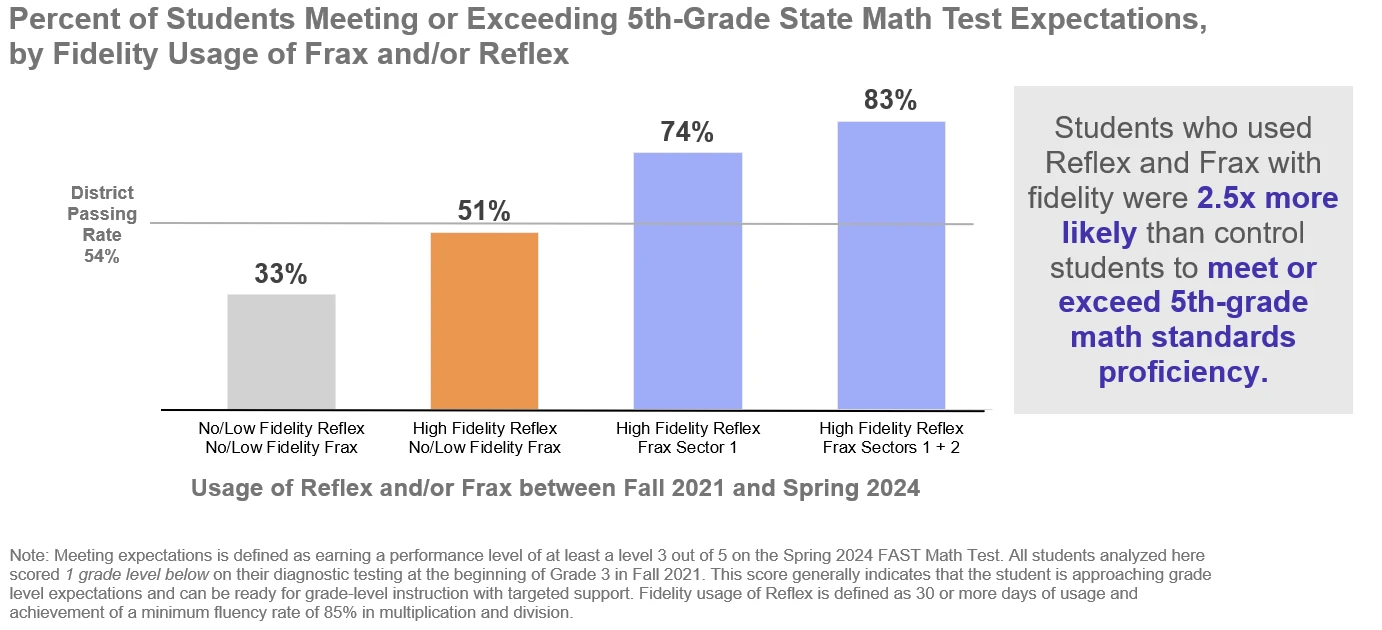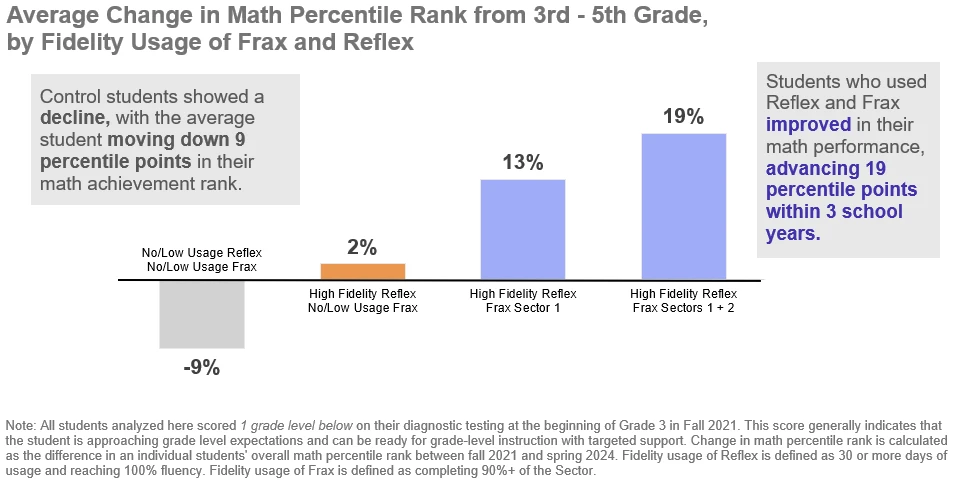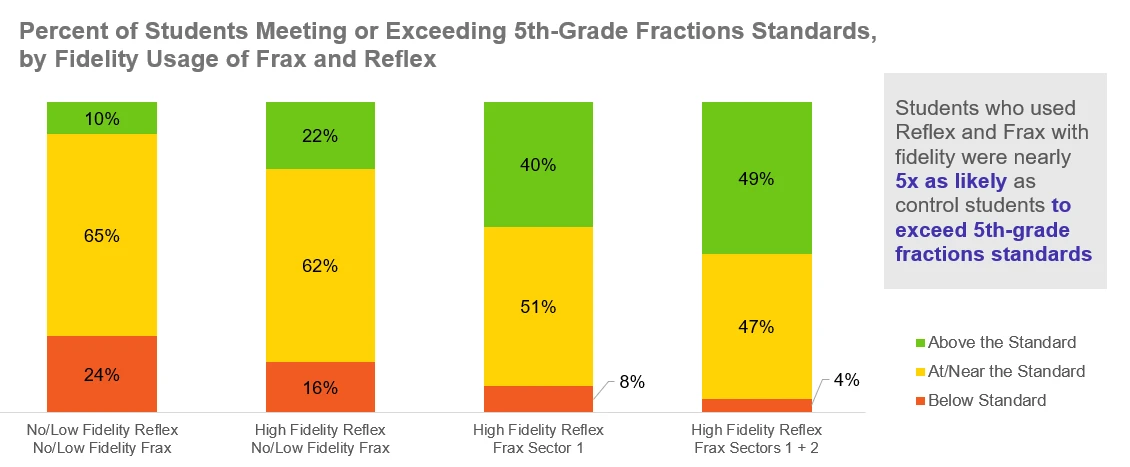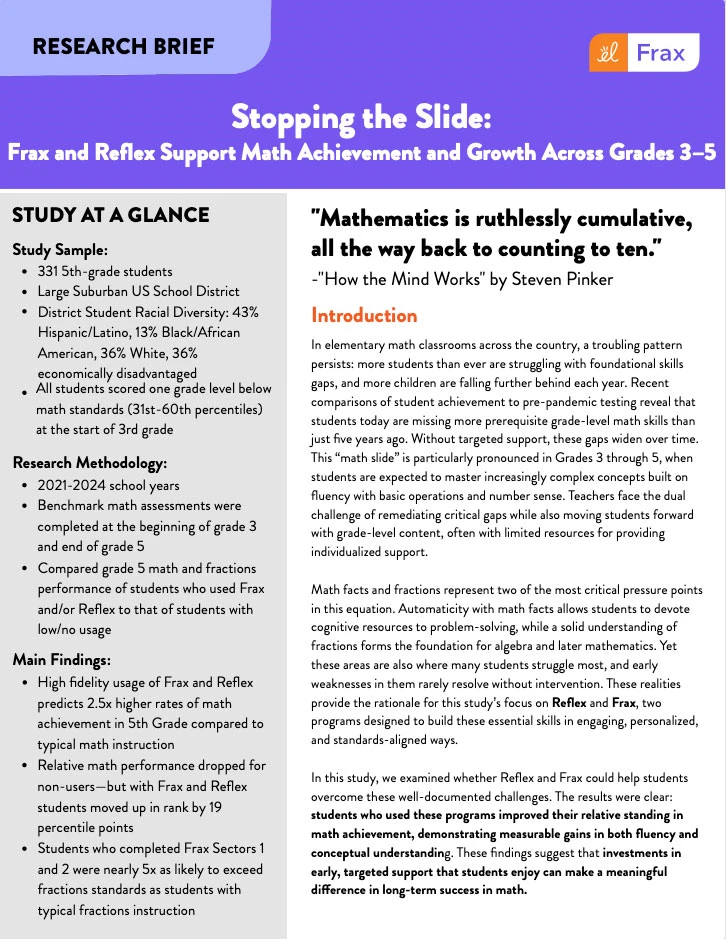
Across elementary classrooms nationwide, educators are grappling with a persistent and growing challenge: students are falling behind in foundational math skills at an alarming rate. Recent data comparing current student performance to pre-pandemic benchmarks reveals a widening gap in prerequisite grade-level math knowledge, especially in grades 3 through 5.
These years are pivotal, as students transition from basic arithmetic to more complex concepts that require fluency in operations and a strong number sense. Teachers are tasked with the difficult balance of addressing these skill gaps while advancing students through grade-level content, searching for individualized resources that are engaging and effective.
A recent longitudinal study, built on a long-term partnership with a large US school district, evaluated the impact of Reflex and Frax, evidence-based math programs designed to build conceptual understanding in math facts and fractions. The long-term data tells a clear story: students who consistently used Reflex and Frax made significant, sustained gains in math achievement across elementary grades.
In contrast, students who did not use Reflex and Frax not only grew more slowly but also fell behind their peers over time, entering 6th grade with larger skill gaps than they had in 2nd grade. The results highlight the measurable return on investment from this partnership and the critical importance of strengthening foundational math skills early, before learning gaps compound.
Math fact fluency and fractions: Critical skills for long-term student success
For educators, few math skills are as foundational and as challenging to teach as math fact fluency and fractions. These two areas are more than just curriculum checkpoints; they are essential building blocks for long-term success in mathematics.
When students achieve fluency with math facts, they free up cognitive space to focus on problem-solving and higher-order thinking. Similarly, a strong understanding of fractions is a direct predictor of algebra readiness and future achievement in middle and high school math. Yet these are precisely the skills where many students begin to fall behind, often as early as third grade.
About the research
Our researchers tracked student progress from a sample of 331 fifth-grade students of a large suburban U.S. school district with notable diversity from 2021 to 2024 using benchmark math assessments administered at the beginning of third grade and the end of fifth grade. All students began third grade scoring one grade level below math standards, falling within the 31st to 60th percentile range.
The study compared the performance of students who used Reflex and/or Frax with those who had low or no usage of the programs, focusing specifically on math fluency and fractions. These pressure points, where students often struggle most, became the lens through which the impact of targeted, personalized support was measured.
Evidence-based tools for math achievement
Reflex and Frax are research-backed programs designed to address those two persistent challenges in elementary math education: fluency with math facts and a conceptual understanding of fractions. Reflex targets students who need support with basic operations (addition, subtraction, multiplication, and division), helping them build automaticity through adaptive, game-based practice. Frax focuses on teaching fractions, guiding students through a carefully sequenced progression of concepts using interactive, story-driven lessons that make abstract ideas more concrete.
Both programs are built to meet students where they are, offering personalized learning paths that adjust based on performance. This targeted approach ensures that students receive the right level of challenge and support, reinforcing foundational skills while preparing them for more advanced math. By combining engaging formats with standards-aligned instruction, Reflex and Frax provide educators with powerful resources that can be used as math intervention tools to close skill gaps and promote long-term achievement.
The current study evaluated differences in student math performance across the later elementary years compared to Reflex and Frax usage. Let’s take a closer look at the results.
Key finding: High fidelity usage of Frax and Reflex predicts 2.5x higher rate of math achievement in 5th grade
Reflex and Frax users showed significantly stronger math achievement by the end of fifth grade, scoring 9 to 20 points higher on average than peers with little or no program use. What else? 83% of students who used both programs met grade-level standards compared to just 33% of those without support, highlighting the powerful impact of targeted, engaging interventions on long-term math success.

Key finding: Reflex and Frax students climbed 19 percentile points
Students who used Reflex and Frax made significantly more progress in math than those who didn’t. On average, they moved up 19 percentile points in achievement rankings over three years. In contrast, students with little or no use of the programs fell behind, dropping about 9 percentile points compared to their peers.

Key finding: Students who completed Frax Sectors 1 and 2 were nearly 5x as likely to exceed fractions standards
Students who completed Frax Sectors 1 and 2 were far more likely to meet or exceed grade-level expectations in fractions – nearly five times more than their peers! Even Reflex alone helped reduce failure rates and boost achievement, but combining both programs gave students a strong foundation that led to standout performance in fifth-grade fractions.

Build critical skills and support academic growth with Reflex and Frax
As this study shows, Reflex and Frax are more than just supplemental tools. They are scalable, evidence-based solutions that help educators tackle some of the most persistent challenges in elementary math. Reflex and Frax empower teachers to close foundational gaps while advancing students toward deeper understanding.
When implemented with fidelity, these tools can make a measurable difference in student outcomes, helping learners build confidence, improve performance, and stay on track for future success in mathematics.

Are you ready to see the difference these digital resources can make for your students? The hardest part is deciding which one to try first!
Sign up to get the latest updates from ExploreLearning via occasional email.